

Most businesses incur two kinds of costs: direct and indirect. They then stay on your balance sheet as an asset.

COGS can also include any discounts on purchase orders or penalties paid when products are returned, among additional fees related to moving inventory where needed most.Īny goods you have in stock and not sold do not go into COGS. This includes the costs associated with manufacturing and production, as well as transportation expenses from point A to point B and other supplies, such as packing materials. The term “Cost of Goods Sold” (COGS) refers to the costs incurred for a company to sell their goods during a specific period. So, if you’re ready to finally demystify COGS and understand why it is so important to your business, let’s get started. Most importantly for small businesses, we explain the differences between COGS and Operating Costs and COGS and Cost of Revenue.
COGS COST OF GOODS SOLD HOW TO
This article explains how to calculate your COGS with the standard formula and different methods (including FIFO and LIFO), what to include in your COGS, and detail the difference between perpetual and periodic inventory tracking systems. Not only is it necessary information for your company’s annual tax return, but it will also help you make better decisions about your business. It’s vital that you understand your COGS and learn how to differentiate it from other business costs. Simply put, the COGS is the cost an organisation incurs for goods used in production, including labor and raw materials. While the concept of COGS seems simple enough, it can be challenging to determine correctly without a lot of research and careful calculation.

Ending inventory: Determine the total value of all items in inventory at the end of the year.Do you regularly add up your cost of goods sold (COGS) but feel somewhat confused or overwhelmed by the required information? You’re not alone.only for the area where the products are being manufactured or assembled. Other costs: This includes indirect labor, shipping containers, freight on materials and supplies, and expenses for rent, light, heat, etc.Cost of materials and supplies: These costs must be directly related to making the product.It doesn't include payroll costs for administrators or employees in sales, marketing, finance, or other areas. Cost of labor: This is your cost for employees who work directly making products from raw materials and parts.If you are making products, you'll need to include the total cost of all raw materials and parts you bought during the year. Subtract any products you took out for personal use. Cost of purchases: Next, get a total of all the products you bought during the year and that you placed in inventory to sell.If it's not the same, you must include an explanation of the difference in your tax return. This should be the same as the inventory at the end of last year. Beginning inventory: This is the total cost of all the products in your inventory at the beginning of the year.You must include an explanation of any changes. Check with your tax preparer if you have changed your method of determining quantities, costs, or valuations. If you use the cash accounting method, you must value inventory at cost. Valuation method: Designate whether inventory is valued at cost, lower of cost or market, or other.


 0 kommentar(er)
0 kommentar(er)
